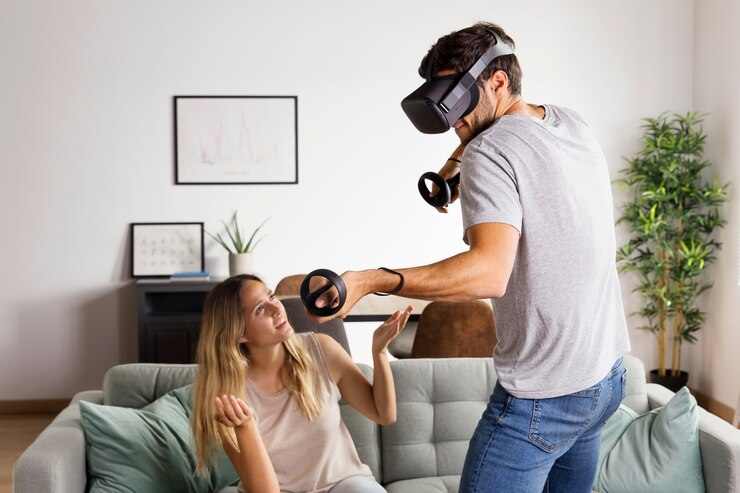The world of mental health treatment is constantly evolving, embracing innovative tools to enhance traditional therapies. Virtual Reality (VR) therapy has emerged as a powerful contender, offering a unique and immersive approach to address several mental health conditions. This blog delves into the exciting potential of VR therapy, specifically focusing on its effectiveness in treating anxiety, phobias, and other conditions by creating safe and controlled environments for exposure therapy.
Understanding VR Therapy
Virtual Reality (VR) therapy leverages cutting-edge computer technology to craft realistic and interactive three-dimensional (3D) environments. Unlike traditional videos or games, VR creates a truly immersive experience. Users don a headset equipped with a screen and sensors. These sensors track the movement and orientation of the head, and sometimes even hands, allowing users to navigate and interact with the virtual world in real time. In some VR therapy setups, users might wear additional equipment like gloves or trackers for even more precise movement detection within the simulation.
This immersive environment is the foundation of VR therapy’s power. Therapists can design virtual scenarios meticulously tailored to address a patient’s specific anxieties or phobias. Let’s delve deeper into how VR therapy works:
Tailored Simulations: Imagine a patient with a fear of public speaking. In VR therapy, the therapist can create a virtual auditorium with a customizable audience. The patient can practice delivering a presentation in this safe and controlled environment, gradually increasing the audience size or complexity of the setting as they progress.
Exposure Therapy Reimagined: VR therapy builds upon the principles of exposure therapy, a well-established technique for treating anxiety disorders and phobias. Traditionally, exposure therapy involves gradually exposing patients to their triggers in a real-world setting. However, this approach can be limited by logistical challenges or safety concerns. VR offers a compelling solution by creating safe and controlled simulations of feared environments.
Graded Challenges: Therapists can control the intensity and pace of exposure within the VR environment. For instance, in the public speaking example, they can start with a small, friendly audience and gradually increase the size or introduce hecklers as the patient gains confidence. This graded approach allows for a more manageable and therapeutic exposure experience.
Traditional Exposure Therapy
Exposure therapy is a cornerstone technique in cognitive-behavioral therapy (CBT), a highly effective treatment approach for anxiety disorders, phobias, and post-traumatic stress disorder (PTSD). It operates on the principle of habituation and extinction learning. Here’s a breakdown of how it works:
Confronting Triggers: The core concept of exposure therapy lies in gradually exposing patients to their anxiety triggers in a controlled setting. This could involve directly facing a feared object, situation, or memory. For example, someone with a fear of heights might be gradually exposed to higher and higher floors of a building, or someone with a fear of public speaking might practice delivering presentations to a small group.
Learning Coping Mechanisms: During exposure therapy sessions, the therapist equips patients with coping mechanisms to manage their anxiety response. These techniques might include relaxation exercises, cognitive restructuring (challenging negative thought patterns), and mindfulness practices. By practicing these coping skills while facing their triggers, patients learn to manage their anxiety and reduce their fear response over time.
Desensitization: Through repeated exposure in a safe environment, patients experience called habituation. This means their body’s automatic fight-or-flight response to the trigger gradually weakens. They become desensitized to the object or situation, and their anxiety levels decrease.
The Power of VR for Exposure Therapy
VR therapy shines in its ability to create safe and immersive environments for exposure therapy. It allows therapists to craft virtual simulations that closely mirror real-world scenarios, empowering patients to confront their anxieties in a controlled setting. Here’s how VR offers several distinct advantages over traditional methods:
Hyper-Customization:
VR environments can be meticulously tailored to address a patient’s anxieties with an unmatched degree of precision. Imagine someone with a fear of public speaking. In VR therapy, the therapist can create a virtual auditorium with a customizable audience. They can adjust the size, demographics, and even the level of attentiveness of the virtual audience. This allows for highly personalized exposure experiences that target the patient’s unique anxieties.
Safety Net for Anxiety:
VR eliminates the potential dangers associated with real-world exposure. For instance, someone with a fear of heights can be gradually exposed to increasing heights within a virtual skyscraper, all from the comfort and safety of a therapist’s office. This significantly reduces the risk of panic or injury, making patients more willing to engage in therapy and progress further.
Granular Control:
Therapists have unparalleled control over the intensity and pace of exposure within the VR environment. They can meticulously adjust the difficulty of the virtual scenarios, from subtle changes in the environment to introducing new elements that trigger anxiety. This granular control allows for a gradual and manageable exposure process, ensuring the patient feels safe and supported throughout the therapy.
Engagement Beyond Imagination:
VR offers a far more engaging and interactive experience compared to traditional exposure therapy. Unlike imagining scenarios, VR immerses patients in a realistic and dynamic environment. This can be particularly beneficial for younger patients who struggle to visualize situations effectively. Additionally, the interactive nature of VR allows patients to practice coping mechanisms and social skills within the virtual world, fostering a sense of agency and accomplishment.
VR Therapy for Anxiety Disorders

Anxiety disorders cast a long shadow, affecting millions of people worldwide. From the paralyzing fear of public speaking to the constant unease of generalized anxiety, these conditions can significantly impair daily life. However, VR therapy emerges as a beacon of hope, offering a new and promising approach to treatment.
Here’s a closer look at how VR therapy tackles specific anxiety disorders:
Social Anxiety Disorder (SAD):
Individuals with SAD experience intense anxiety in social situations, fearing scrutiny and judgment. VR simulations can create safe spaces for them to practice social interactions they dread. Imagine a virtual classroom where someone with SAD can gradually confront giving presentations to a small group, and then a larger audience. Therapists can customize the virtual environment, including the size and demeanor of the audience, to precisely target the patient’s anxieties. Studies like the one referenced, demonstrating VR therapy’s effectiveness as CBT for SAD, highlight its potential to significantly improve social interaction skills and reduce anxiety in real-world settings.
Generalized Anxiety Disorder (GAD):
For those struggling with GAD, a constant sense of worry and unease permeates daily life. VR therapy can be used to create scenarios that trigger generalized anxiety in a controlled environment. For instance, a virtual environment filled with traffic jams or crowded spaces can be used to expose patients to their triggers. However, unlike real-world situations, therapists can control the intensity and duration of these triggers. This allows patients to practice relaxation techniques and coping mechanisms, such as deep breathing or mindfulness exercises, within the VR environment. Learning to manage anxiety in a safe, controlled setting builds confidence and empowers patients to apply these skills to real-life situations.
Phobias:
Phobias are intense and irrational fears of specific objects or situations. VR exposure therapy has shown particular effectiveness in treating phobias. Let’s consider arachnophobia, the fear of spiders. Traditional exposure therapy might involve gradually exposing patients to real spiders in a controlled setting. However, VR allows for a more controlled and graded approach. Therapists can create virtual environments with progressively more spiders, allowing patients to confront their fears in a safe and manageable way. Research suggests VR therapy can be even more effective than traditional exposure therapy for phobias. This is likely due to the ability to control the intensity and customization of the virtual environment, making the exposure process less overwhelming and more successful.
VR Therapy Beyond Anxiety
While VR therapy shines in its ability to combat anxiety disorders, its potential extends far beyond. Researchers are actively exploring its application as a treatment tool for a diverse range of mental health conditions, offering a glimmer of hope for individuals struggling with various challenges. Here’s a glimpse into how VR therapy is venturing into new territories:
Post-Traumatic Stress Disorder (PTSD):
For individuals grappling with PTSD, intrusive memories and nightmares can be debilitating. VR therapy offers a safe and controlled environment to confront these memories. Therapists can design virtual simulations that recreate specific aspects of the traumatic event, allowing patients to process their experiences in a gradual and manageable way. For instance, a soldier with war-related PTSD might be exposed to a virtual battlefield environment, but with the ability to control the intensity and pacing of the experience. This controlled exposure can help patients develop coping mechanisms and reduce the frequency and intensity of flashbacks and nightmares.
Depression:
Depression often manifests as feelings of hopelessness, isolation, and a lack of motivation. VR therapy can create positive and calming virtual environments that counteract these symptoms. Imagine a virtual beach with gentle waves and calming sounds, or a serene mountain vista. These immersive experiences can promote relaxation and provide a sense of escape from negative thoughts and feelings. Additionally, VR can create virtual social interactions, helping individuals with depression overcome social isolation and practice social skills in a safe and controlled setting.
Chronic Pain:
Chronic pain can be a relentless adversary, significantly impacting a person’s quality of life. VR therapy offers a promising approach to pain management. By creating immersive and engaging virtual environments, VR can distract patients from the pain sensation. Imagine a virtual reality world filled with beautiful landscapes or captivating games. This distraction can help patients manage their pain more effectively and reduce reliance on pain medication. Furthermore, VR can teach relaxation techniques like guided meditations or deep breathing exercises within the virtual environment, further promoting pain management and overall well-being.
The Future of VR Therapy
VR therapy is a rapidly evolving field with immense potential to revolutionize mental health treatment. As VR technology continues to develop, we can expect even more sophisticated and effective applications to emerge. Here are some exciting possibilities for the future:
Virtual Reality Group Therapy: VR can facilitate group therapy sessions in virtual environments, making therapy more accessible for individuals who struggle with attending in-person sessions.
Remote VR Therapy: VR therapy can be delivered remotely, making it a viable option for individuals who live in areas with limited access to mental health professionals.
Development of VR Apps: The creation of VR apps specifically designed for mental health treatment can further personalize and streamline therapy experiences.
Conclusion
VR therapy offers a groundbreaking approach to mental health treatment, particularly for anxiety disorders, phobias, and other conditions. By creating safe and immersive environments for exposure therapy, VR empowers patients to confront their fears and develop coping mechanisms. As research continues to explore the potential of VR therapy, we can expect this technology to become a valuable tool in the mental health professional’s toolkit, offering a more engaging and effective path to healing for many individuals.


